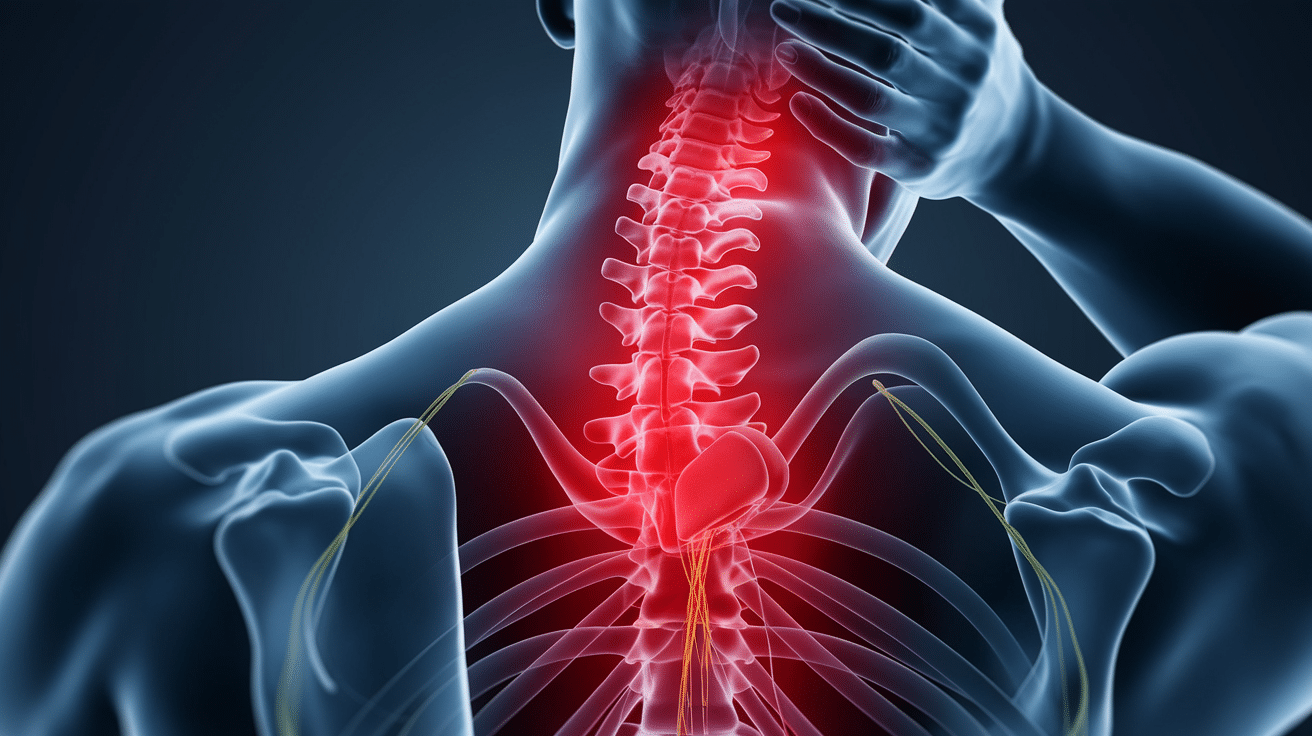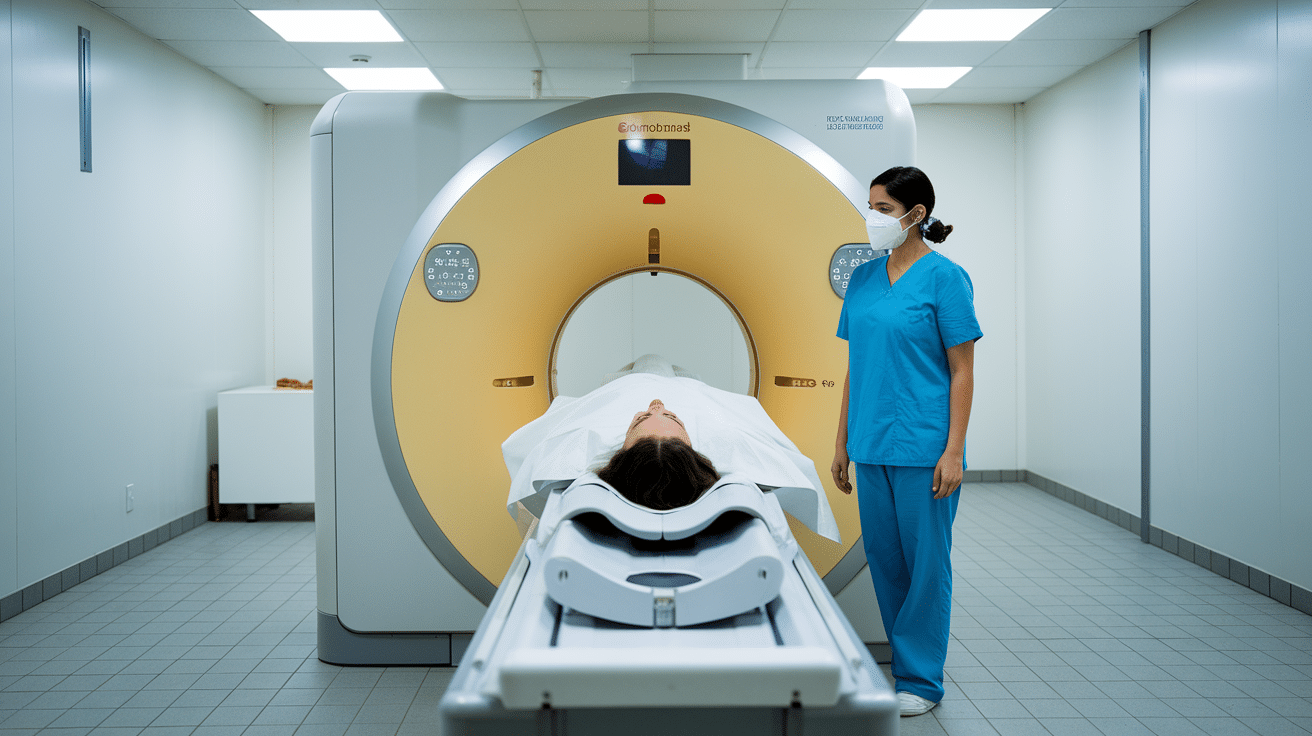Waking up with a stiff neck that makes you feel queasy can ruin your entire day.
Well, neck pain and nausea often occur together, affecting millions of people who struggle to understand why these symptoms are connected.
The relationship between neck discomfort and stomach upset is more common than you might think, especially in our screen-heavy world.
This blog will help you understand exactly why neck pain and nausea happen together and what you can do about it.
We’ll study the main causes behind these symptoms, from simple muscle strain to serious conditions. You’ll also learn useful prevention strategies, learn when to seek medical care, and find effective treatments.
By the end, you’ll have the knowledge to identify your symptoms and do the right things to feel better.
Why Do You Have Neck Pain And Feel Nauseous?
The connection between neck pain and nausea isn’t coincidental-your neck contains vital nerves and blood vessels that directly influence balance and stomach function.
When neck muscles tense or joints misalign, they compress nerves that send mixed signals to your brain, often triggering nausea alongside physical discomfort.
Dizziness can result from damage to the nerves in the neck. This can also make you feel nauseous, which is also known as having a “queasy” feeling.
Common Causes of Neck Pain And Nausea
Understanding what triggers these symptoms together can help you find the right treatment approach.
1. Muscle Strain and Tension
Spending hours hunched over a computer or constantly looking down at your phone creates significant stress on neck muscles.
When these muscles become tight and overworked, they can disrupt your body’s balance system. This disruption often triggers both pain in the neck area and feelings of dizziness.
Who’s Most At Risk?
- Office workers and students with prolonged computer use
- Frequent smartphone and tablet users
- People in high-stress jobs or situations
- Those who sleep on their stomach or use multiple pillows
- Individuals with anxiety or depression who carry physical tension
2. Cervical Spine Disorders
Your cervical spine contains seven vertebrae that protect vital nerves controlling balance and sensation. Age-related wear, herniated discs, or conditions like cervical spondylosis can compress these nerves.
When compressed, these nerves send mixed signals to your brain, affecting both pain perception and your sense of equilibrium.
Who’s Most At Risk?
- Adults over 50 are experiencing natural wear and tear
- People with a family history of spinal problems
- Those with previous neck injuries or trauma
- Workers in physically demanding jobs like construction
- Individuals with arthritis or inflammatory conditions
3. Whiplash and Neck Injuries
Sudden, forceful movements during accidents cause the neck to snap back and forth rapidly. This trauma damages soft tissues, including muscles, ligaments, and nerves that control balance.
The resulting injury can create persistent discomfort and queasiness that may last for months.
Who’s Most At Risk?
- Drivers and passengers in rear-end collisions
- Contact sport athletes (football, hockey, rugby)
- Older adults are more susceptible to falls
- People with smaller frames or weaker neck muscles
- Those with a history of previous neck injuries
4. Cervicogenic Headaches And Migraines
Some headaches originate from neck problems rather than head issues. These headaches typically start at the skull’s base and radiate upward, often accompanied by nausea.
The connection between neck dysfunction and stomach upset creates a challenging cycle of symptoms.
Who’s Most At Risk?
- Women (three times more likely than men)
- People aged 25-55 years
- Individuals with poor posture or forward head positioning
- Those with a family history of migraines
- Workers in high-stress environments
5. Meningitis And Infections
Serious infections like meningitis cause severe neck stiffness alongside nausea, fever, and headache. This represents a medical emergency requiring immediate attention.
Other neck area infections can also trigger these symptoms, though typically less severely.
Who’s Most At Risk?
- Infants, children, and teenagers
- Adults over 60 with weakened immune systems
- People in close living quarters (dorms, barracks)
- Individuals with compromised immunity or chronic illness
- Those missing recommended vaccinations
Lifestyle Factors That Worsen Neck Pain And Nausea
Certain daily habits can make your symptoms worse, even when you’re following treatment.
| Factor | How It Affects Symptoms | What to Avoid |
|---|---|---|
| Dehydration | Reduces muscle function and triggers both neck tension and nausea | Skipping water intake, excessive caffeine, or alcohol |
| Medication Overuse | Creates rebound headaches that cause neck pain and nausea | Taking pain relievers more than 2-3 days per week |
| Sleep Deprivation | Increases pain sensitivity and disrupts balance, worsening nausea | Getting less than 7 hours of sleep regularly |
| Hormonal Changes | Triggers neck muscle tension and nausea, especially in women | Ignoring menstrual cycle patterns, skipping meals during hormonal shifts |
| Weather Changes | Atmospheric pressure affects neck joints and can trigger nausea | Staying indoors during pressure drops, not adjusting activity levels |
When to Seek Help for Neck Pain and Nausea?
Get emergency care for stiff neck with high fever, severe headache. See a doctor urgently if symptoms last over 3 days, cause arm numbness, or don't improve with medication.
Diagnosing Neck Pain And Nausea
Getting the right diagnosis is the first step toward feeling better and finding relief.
1. Physical Examination
Healthcare providers assess your range of motion and identify tender areas. They’ll ask detailed questions about when symptoms started, what activities worsen them, and any recent injuries or lifestyle changes.
What to Expect:
- Range of motion tests to evaluate neck movement
- Palpation to locate tender spots and muscle tension
- Neurological tests checking reflexes and nerve function
- Balance and coordination assessments when dizziness is present
2. Imaging Tests
When physical examination suggests structural problems, imaging helps identify specific causes of your symptoms.
What to Expect:
- X-rays: Reveal bone problems, fractures, and alignment issues
- MRI scans: Provide detailed views of soft tissues, discs, and nerves
- CT scans: Show comprehensive bone and soft tissue details
- Ultrasound: Examines soft tissues and blood flow patterns
3. Laboratory Tests
Blood work may be ordered when infection or inflammatory conditions are suspected, particularly when fever accompanies other symptoms.
What to Expect:
- Complete blood count checking for infection signs
- Inflammatory markers detect conditions like arthritis
- Specific tests for autoimmune disorders if symptoms suggest them
Treating Neck Pain and Nausea
Once you know what’s causing your symptoms, you can start working on solutions that bring real relief.
1. Conservative Therapies
a) Physical Therapy
Strengthens neck muscles and improves posture while teaching proper movement patterns to reduce muscle imbalances that contribute to neck pain and nausea.
b) Massage Therapy
Relieves muscle tension and spasms while improving blood circulation to affected areas, providing immediate comfort for stress-related symptoms.
c) Chiropractic Care
Addresses spinal alignment and joint mobility through gentle adjustments that restore normal function and tackle underlying mechanical causes.
d) Heat and Cold Therapy
Ice reduces inflammation in acute injuries while heat relaxes tense muscles and improves circulation, with alternating treatments providing optimal relief.
2. Medical Interventions
a) Over-the-Counter Medications
Ibuprofen or acetaminophen helps manage pain, while anti-inflammatory drugs target swelling and nerve irritation that may contribute to associated nausea.
b) Prescription Medications
Muscle relaxants break cycles of muscle spasms, stronger pain medications address severe cases, and anti-nausea medications help when symptoms persist.
c) Surgical Options
Reserved for severe structural problems and considered only when conservative treatments fail, typically addressing nerve compression or spinal cord threats.
Neck Pain And Nausea Recovery Timeline
Recovery times vary based on what’s causing your symptoms and how well you follow your treatment plan.
| Condition | Initial Relief | Significant Improvement | Full Recovery | Factors Affecting Timeline |
|---|---|---|---|---|
| Muscle Strain/Tension | 24-48 hours | 3-7 days | 1-2 weeks | Stress levels, posture habits, and sleep quality |
| Whiplash (Mild) | 3-5 days | 2-4 weeks | 6-12 weeks | Age, severity of impact, and previous injuries |
| Whiplash (Moderate-Severe) | 1-2 weeks | 6-12 weeks | 3-6 months | Compliance with therapy, overall health |
| Cervical Spine Disorders | 2-4 weeks | 6-12 weeks | 3-6 months (ongoing management) | Age, severity, and response to treatment |
| Cervicogenic Headaches | 1-2 weeks | 4-8 weeks | 2-4 months | Trigger identification, lifestyle changes |
| Post-Infection Recovery | 1-3 days (after treatment) | 1-2 weeks | 2-4 weeks | Type of infection, immune system strength |
Preventing Neck Pain and Nausea
Taking simple steps now can help you avoid these uncomfortable symptoms in the future.
1. Maintain Proper Posture
Good posture forms the foundation for preventing neck pain and nausea. Keep your head aligned over your shoulders, especially when working at computers or using mobile devices.
Position your ears directly over your shoulders, keep your chin parallel to the floor, and pull your shoulder blades back and down while avoiding slouching or hunching forward.
Quick Start Tip: Set hourly phone reminders to check if your ears are over your shoulders.
2. Take Regular Movement Breaks
Prolonged static positions create muscle tension that can trigger symptoms. Breaking up long periods of sitting or repetitive activities gives your neck muscles essential rest.
Stand and move every 30-60 minutes during desk work, perform gentle neck stretches throughout the day, and limit continuous device use to 20-minute intervals.
Quick Start Tip: Use your phone’s timer to remind you to stand up every 30 minutes today.
3. Create An Ergonomic Workspace
Your work environment has a significant impact on your neck health. Proper setup reduces strain and prevents the muscle tension that leads to both pain and nausea.
Position computer screens at eye level, keep keyboards and mice close to your body, use a document holder to avoid looking down, and ensure adequate lighting to prevent squinting.
Quick Start Tip: Stack books under your laptop or monitor right now to raise the screen to eye level.
4. Optimize Your Sleep Setup
Your sleeping position and pillow choice significantly affect whether you wake up with neck discomfort and associated nausea.
Choose pillows that maintain your neck’s natural curve, sleep on your back or side rather than your stomach, replace old unsupportive pillows regularly, and consider a contoured or cervical support pillow.
Quick Start Tip: Check your pillow tonight – if it’s flat or lumpy, fold a towel to support your neck’s curve.
5. Strengthen Supporting Muscles and Manage Stress
Regular exercises build the muscle strength needed to support proper posture and prevent neck strain. Perform gentle neck rotations in both directions, do resistance exercises using your hand against your head, and practice shoulder blade squeezes.
Additionally, manage emotional tension through deep breathing exercises, meditation, and regular physical exercise, as stress often manifests as physical tightness in the neck and shoulders.
Quick Start Tip: Do 5 slow neck rotations in each direction, then take three deep breaths while relaxing your neck and shoulders.
Final Thoughts
Understanding the connection between neck pain and nausea empowers you to take control of your health.
These symptoms often stem from everyday habits like poor posture, stress, or inadequate sleep; factors you can actively address. Though muscle strain accounts for many cases, identifying serious symptoms can prevent dangerous complications.
The preventative measures outlined offer practical ways to reduce your risk of developing these symptoms.
Simple changes like improving your workspace setup, taking regular breaks, and managing stress can make a significant difference.
Remember that persistent neck pain and nausea shouldn’t be ignored.
From physical therapy to medical treatments, taking early action improves your recovery prospects. Start implementing these strategies today, and consult healthcare providers when symptoms concern you.
Frequently Asked Questions
What Illness Starts with Neck Pain?
Several illnesses start with neck pain, including meningitis, cervical spine disorders, whiplash injuries, muscle strain, and infections. Meningitis is the most serious concern.
What is a Red Flag for Neck Pain?
A stiff neck with high fever, severe headache, persistent vomiting, confusion, or difficulty breathing is a serious red flag requiring immediate emergency medical attention.
















